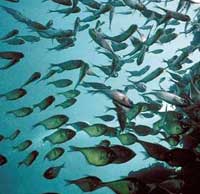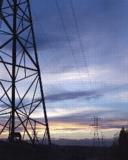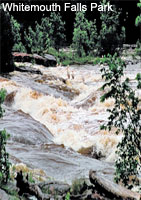
News |
- NRTEE Slams Government's Kyoto Act Plan
- Canada's Kyoto Plan Triggers Lawsuit
- US Court Battles Over Car Emissions
- Pacific Gray Whales Starving
- Audit Update - Manitoba & Climate Change
- Cottage Lots Tip of Iceberg in Hollow Water Blockade
- Aboriginal Leaders Employ 'Aggressive Advocacy'
- Manitoba Hydro to Rebuild Manitoba's Oldest Dam
- Panel Recommends Against Lake for Mine Waste
- Film Prompts Counter-Website by Manitoba Hydro
- Bipole III to be Routed Through Manitoba's West Side
- Protected Areas Gains And Losses
| NRTEE Slams Government's Kyoto Act Plan | 17 October 07 |
 According to Canada's National Round Table on the Environment and the Economy (NRTEE), the plan prepared by the federal government in response to obligations under Canada's Kyoto Protocol Implementation Act exaggerates benefits and does not provide sufficient information to justify its actions. According to Canada's National Round Table on the Environment and the Economy (NRTEE), the plan prepared by the federal government in response to obligations under Canada's Kyoto Protocol Implementation Act exaggerates benefits and does not provide sufficient information to justify its actions.Further, the August 2007 plan will not enable Canada to meet its target for the 2008-2012 commitment period under the Kyoto Protocol. The NRTEE was careful not to pass judgment on the advisability of any government initiatives in their report, yet the report is highly critical of the government's methods and assumptions in projecting programs' results. Under Canada's Kyoto Protocol Implementation Act, the Roundtable was required to advise the government on the effectiveness of its climate-change plan within 30 days of its release. "This kind of lack of rigour, lack of seriousness about understanding emission-reduction impact of policies, when you contrast it with the seriousness given to financial projections in government budgets, sends a message that environmental performance is a poor cousin," said Matthew Bramley of Pembina Institute. View September 2007 NRTEE report, Response of the National Round Table on the Environment and the Economy to its Obligations Under the Kyoto Protocol Implementation Act View September 24, 2007 Canadian Press article View September 22, 2007 Toronto Star article View September 21, 2007 Canadian Press article in Toronto Star Visit Manitoba Wildlands Climate Change - Canada Initiatives page Sources: Canadian Press, Toronto Star, NRTEE
|
|
| Canada's Kyoto Plan Triggers Lawsuit | 10 October 07 |
 The Government of Canada is facing a legal challenge for refusing to respect a federal law that requires reductions in greenhouse gas emissions. The Government of Canada is facing a legal challenge for refusing to respect a federal law that requires reductions in greenhouse gas emissions.EcoJustice (formerly Sierra Legal) filed an Application for Judicial Review with the Federal Court on behalf of Friends of the Earth Canada that seeks to force the Government to comply with the Kyoto Protocol Implementation Act. Under the legislation, the government was legally required to publish, within 60 days, a plan to comply with commitments under the Kyoto Protocol. The September 19th Application alleges the federal Minister of the Environment is ignoring rule of law by filing a plan that flouts legislation binding the government to strict targets. "Canadians have made it clear they want action on climate change - in fact, our domestic law requires it," says EcoJustice lawyer Albert Koehl. "Most Canadians just want the government to act now to reduce emissions and to live up to our obligations." A Federal Court judge could theoretically respond to the application by ordering the government to file a new plan in keeping with the Kyoto Protocol, and Canadian law. View September 20, 2007 Friends of the Earth Canada press release View media backgrounder (PDF) View September 19, 2007 Application for Judicial Review (PDF) View September 20, 2007 Globe and Mail article on EcoJustice site View September 20, 2007 Canadian Press article Sources: Friends of the Earth Canada, EcoJustice, Globe and Mail
|
|
| US Court Battles Over Car Emissions | 10 October 07 |
 Detroit's Big Three automakers and Toyota Motor Corp. announced October 5th they would appeal the decision by a Vermont judge that allows the state to set its own aggressive regulations on tailpipe emissions. This is the latest in the ongoing legal battle over whether US states have the right to set regulations on emissions from cars. Detroit's Big Three automakers and Toyota Motor Corp. announced October 5th they would appeal the decision by a Vermont judge that allows the state to set its own aggressive regulations on tailpipe emissions. This is the latest in the ongoing legal battle over whether US states have the right to set regulations on emissions from cars.Vermont and a handful of other states are seeking to implement tailpipe emissions standards to require vehicles to achieve upwards of 40 miles a gallon. Increases in fuel efficiency would begin 2009. Automakers have also sued California to prevent the state from instituting its regulations. Federal District Judge William K. Sessions III rejected the industry's arguments in a September 12, 2007 240-page decision. California is awaiting a waiver from the Environmental Protection Agency to allow the state to set tailpipe emissions rules and has threatened to sue the federal agency unless it acts by Oct. 25. "The EPA is going to be hard-pressed to say the (state) regulations aren't feasible or are too costly," said David Doniger, a lawyer with the Natural Resources Defense Council who helped argue the Vermont case and is taking part in a similar California lawsuit. View October 8, 2007 Reuters article View October 5, 2007 Wall Street Journal article View October 3, 2007 Reuters article View September 14, 2007 Christian Science Monitor article View September 13, 2007 San Francisco Chronicle article Sources: San Francisco Chronicle, Wall Street Journal, Reuters
|
|
| Pacific Gray Whales Starving | 10 October 07 |
 According to a new study, starvation may be impeding recovery of the Pacific Gray whale population - and climate change may be part of the reason. According to a new study, starvation may be impeding recovery of the Pacific Gray whale population - and climate change may be part of the reason.A new genetic study suggests the mammals once numbered between three and five times the 22,000 estimate of today. If confirmed, says study author Stephen Palumbi of Stanford University, this implies the world's oceans are no longer able to support the number of whales they once could. "Our results might be telling us whales now face a new threat - from changes to the oceans that limit their recovery," says Palumbi. "Decades ago, whales were the first creatures to tell us we were over-fishing oceans. Perhaps they are now telling us the oceans are in deeper trouble." For Palumbi the logical conclusion is the oceans are no longer able to feed as many Gray whales. He says reasons could range from natural variation of the ocean's food supply, to human effects on oceans. He also points to a 2006 study that showed warming seas in the Arctic are displacing crustaceans on which the whales feed. View September 11, 2007 New Scientist Environment article Watch YouTube video on gray whale starvation View September 11, 2007 National Academy of Sciences journal article, DNA evidence for historic population size and past ecosystem impacts of gray whales Source: New Scientist Environment
|
|
| Audit Update - Manitoba & Climate Change | 04 October 07 |
 Manitoba Wildlands' audit of Manitoba government climate change targets, actions and commitments continues. Manitoba Wildlands' audit of Manitoba government climate change targets, actions and commitments continues.The second stage of the Audit includes review of action for commitments in Manitoba's 2002 Climate Action Plan, and in the 2007 Council of he Federation (All Premiers Council for Canada) climate change report, Manitoba sections. To highlight the climate change audit research and analysis, Manitoba Wildlands has added a new page to its Climate Change section, 'Audit - Manitoba Climate Change'. The Manitoba Wildlands climate change audit found that very little government information about Manitoba's actions has been released. "If the Manitoba government is taking action, addressing recommendations of the 2001 Task Force, or its 2002 Climate Change Action Plan and really reducing GHG emissions, it is very difficult to verify," says Manitoba Wildlands Director Gaile Whelan Enns. "We would rather be in a position to boast about Manitoba's accomplishments and instead - because of the scarcity of reporting - we are left to wonder what is happening in Manitoba?" View Manitoba Wildlands' listing of 2001 Manitoba Climate Change Task Force report recommendations (PDF) View Manitoba Wildlands' October 2007 Analysis of the 2002 Kyoto and Beyond report (PDF) View Manitoba Wildlands' October 2007 Analysis of the 2007 Council of the Federation Climate Change report (PDF) View Manitoba Wildlands' September 12, 2007 news item Visit Manitoba Wildlands' new 'Audit - Manitoba Climate Change' webpage Source: Manitoba Wildlands
|
|
| Cottage Lots Tip of Iceberg in Hollow Water Blockade | 03 October 07 |
 The inclusion of Hollow Water First Nation traditional lands in a provincial cottage lot draw triggered an ongoing blockade erected on Highway 304 September 14. But larger issues surrounding recognition of Aboriginal rights, land use decisions, benefits and revenue for First Nations and government commitment to deal with Aboriginal peoples in good faith are emerging. The inclusion of Hollow Water First Nation traditional lands in a provincial cottage lot draw triggered an ongoing blockade erected on Highway 304 September 14. But larger issues surrounding recognition of Aboriginal rights, land use decisions, benefits and revenue for First Nations and government commitment to deal with Aboriginal peoples in good faith are emerging.Hollow Water First Nation is accusing the Manitoba government of failing to meaningfully consult before proceeding with development within its traditional lands. Conservation Minister Struthers is disputing that claim, producing paperwork detailing attempts to contact and discuss the Province's planned cottage development. A member of Hollow Water says, the government 'consultation' has consisted of sending out faxes and letters to "tell" the people that development would be forthcoming, not to involve them. There are also reports that benefits derived from taxes and selling of cottage lots, ranging from $7000 - $47,000 each, are to be Provincial revenue, with no services, or benefits to local communities of Hollow Water, Seymourville, Aghaming, or Manigotagan. Manitoba is in the midst of a precedent-setting east side land use planning experiment - the Wabanong Nakayguy Okimawin (WNO) - intended to result in aboriginal people making decisions and seeing revenue from activities within their traditional lands. The April 2007 WNO Accord between Manitoba and First Nation members of WNO confirms a partnership of sharing and consultation regarding land use decisions on Manitoba's east side. It mandates each First Nation within the planning area to create its own traditional lands plan. The WNO also mandates that new projects on Crown land won't happen without consulting First Nations in a meaningful way. Decisions to protect boreal lands on the east side are also pending, with the government committing in spring 2007 to honour protected lands selections made by First Nations. Questions are being raised as to the Manitoba government's commitment to the WNO Accord and its principles, given the situation at Hollow Water. Visit web blog, Little Black Bear - Keeping an Eye on Hollow Water First Nation View October 1, 2007 Winnipeg Free Press article (DOC) View September 29, 2007 Winnipeg Free Press article (DOC) View September 24, 2007 CBC News article View Manitoba Wildlands Wabanong Nakayguy Okimawin (WNO) and East Side Planning Initiative pages Sources: CBC News, Winnipeg Free Press, Little Black Bear Blog, Manitoba Wildlands
|
|
| Aboriginal Leaders Employ 'Aggressive Advocacy' | 02 October 07 |
 On August 16, 2007, Nishnawbe Aski Nation (NAN), political leadership for 49 First Nations in northern Ontario, passed a resolution expressing their frustration with the Ontario Government's policies with regard to mining and Aboriginal peoples. Various member nations have objected to exploration without notification or consent, with court cases ongoing. The Ontario government has been ordered by the courts to consult in a meaningful manner. On August 16, 2007, Nishnawbe Aski Nation (NAN), political leadership for 49 First Nations in northern Ontario, passed a resolution expressing their frustration with the Ontario Government's policies with regard to mining and Aboriginal peoples. Various member nations have objected to exploration without notification or consent, with court cases ongoing. The Ontario government has been ordered by the courts to consult in a meaningful manner.Resolution 07/71 accuses Ontario Northern Development and Mines (MNDM) of "giving advice to mining companies on how to circumvent these rights and interests", and resolves to "aggressively advocate a more positive shift in MNDM's approach to dealing with First Nation mining issues within Nishnawbe Aski territory". NAN sent an open letter to all four leaders of Ontario political parties September 17th, stating NAN's requirement for a "strong commitment to an action-oriented agenda that respects First Nation priorities: resource revenue sharing, impact and benefit agreement legislation, consultation, accommodation, and consent, respect for community moratoriums, and far north land use planning." Ontarians vote in a provincial election October 10, 2007. The Nishnawbe Aski Nation (NAN) covers an area two-thirds the size of Ontario, represents 49 First Nation communities with 45,000 members on and off reserve. View NAN's August 16, 2007 Resolution 07/71 (PDF) View NAN's September 17, 2007 open letter to Ontario Party Leaders (PDF) Visit NAN's website View Ontario Law Society newsletter article by Kate Kempton (PDF) Sources: NAN, MiningWatch Canada
|
|
| Manitoba Hydro to Rebuild Manitoba's Oldest Dam | 02 October 07 |
 On July 31, 2007, Manitoba Hydro submitted a proposal under the Environment Act to rebuild the oldest hydroelectric plant operating in Manitoba, which began producing power in 1911. On July 31, 2007, Manitoba Hydro submitted a proposal under the Environment Act to rebuild the oldest hydroelectric plant operating in Manitoba, which began producing power in 1911.The Pointe du Bois Modernization Project will involve construction of a new generating station and decommissioning of existing facilities on the Winnipeg River. The capacity of the dam increases from 78 MW to approximately 120 MW at an estimated cost of $800 million. Manitoba Hydro is seeking separate regulatory approval for two other related projects (transmission line improvements and the conversion of a tramway to an all-weather road). This approach creates a risk that impacts from the overall development (all three components) will not be considered. Manitoba Wildlands provided comments on the Draft Scoping Document for the Pointe du Bois Modernization project during the public comment period. "This is one of six dams slated for rebuilding. Our utility needs to disclose the whole $8 billion plan for the Winnipeg River," stated Gaile Whelan Enns, director, Manitoba Wildlands. View Environmental Assessment and Licensing Branch webpage for Pointe du Bois Project View Environment Act Proposal and Draft Scoping Document for Pointe du Bois Project (PDF) View Manitoba Hydro webpage for Pointe du Bois Project View Environmental Assessment and Licensing Branch webpage for Slave Falls Tramway project View Manitoba Wildlands' September 25, 2007 comments on Draft Scoping Document for Pointe du Bois Modernization project (PDF) Sources: Manitoba Hydro, Manitoba Wildlands
|
|
| Panel Recommends Against Lake for Mine Waste | 02 October 07 |
|
s recommendation not to approve the project. Sources: Globe and Mail, CBC, Prince George Citizen
|
|
| Film Prompts Counter-Website by Manitoba Hydro | 28 September 07 |
 You know you are making an impact when you are targeted by a counter-information campaign. GreenGreenWaterBiased.com appeared summer 2007 with the purpose of countering Green Green Water. The documentary tells the story of impacts from hydro development on northern Manitoba Aboriginal communities. You know you are making an impact when you are targeted by a counter-information campaign. GreenGreenWaterBiased.com appeared summer 2007 with the purpose of countering Green Green Water. The documentary tells the story of impacts from hydro development on northern Manitoba Aboriginal communities.The domain of the new website has been revealed as being held by Manitoba Hydro. "[A]fter reading information on this site, which is largely misleading and inaccurate, it was no surprise to discover the domain is registered to Manitoba Hydro. I'm honestly surprised and mildly flattered they would take the time and energy to create this site, but saddened because the costs going into this site could have been used to settle damage claims with members of Northern Manitoba First Nation communities," says Minnesota filmmaker, Dawn Mikkelson. GreenGreenWaterBiased.com accuses Green Green Water (the film) of being unbalanced, incomplete and incorrect. The filmmakers are refuting accusations of factual inaccuracy, saying the purpose of the film was to "provide a platform for the voices of those in the communities who have been silenced by the power and money behind pro-dam forces". Green Green Water reflects differing viewpoints within these communities; viewpoints that would never be heard in the United States if not for projects like Green Green Water. Visit website of the documentary film, Green Green Water Visit Manitoba Hydro website - GreenGreenWaterBiased.com View previous Manitoba Wildlands' news items: March 16, 2006 & October 25, 2005 Sources: Green Green Water, GreenGreenWaterBiased.com
|
|
| Bipole III to be Routed Through Manitoba's West Side | 28 September 07 |
 Manitoba Hydro announced September 25, 2007 it will move forward with plans to build a new high voltage direct current (HVDC) transmission line, known as BiPole III, on the west side of the Province. Manitoba Hydro announced September 25, 2007 it will move forward with plans to build a new high voltage direct current (HVDC) transmission line, known as BiPole III, on the west side of the Province.Originally Hydro planned to bring the line down the boreal forest regions east of Lake Winnipeg. In 2005 the Manitoba government axed that plan and committed to preserving the ecological integrity of boreal forests on the east side - to assist in pursuit of World Heritage Site status for the area. Manitoba Hydro President and CEO Bob Brennan said the new line will serve as backup for existing lines, which are vulnerable to storms and extreme weather. Brennan said the switch to the west will add up to $400 million to the cost of the transmission line, bringing the total to $1.1 billion. When converter equipment is added, the total cost is $2.2 billion. The western route is 50 per cent longer and resistance on the longer line will cause more electricity to be lost. Environmentalists have applauded the decision, saying that maintaining untouched boreal forest regions is worth the cost. "If you count and value all the ecological services Manitobans and Canadians receive from the intact waterways and rivers and forest lands on the east side - absolutely we'll get $500 million back in ecological services in a short time," said Gaile Whelan Enns of Manitoba Wildlands. The transmission project will need to receive approvals from the appropriate federal and provincial agencies. Targeted in-service date is 2017. View September 25, 2007 Manitoba Hydro press release View September 27, 2007 CBC News article View September 27, 2007 Winnipeg Free Press article (DOC) View September 26, 2007 Winnipeg Sun article Sources: Manitoba Hydro, CBC News, Winnipeg Free Press, Winnipeg Sun
|
|
| Protected Areas Gains And Losses | 25 September 07 |
 Although announced as expansion of Manitoba's parks, protected land has both been added and lost as a result of September 2007 Manitoba Conservation decisions. Although announced as expansion of Manitoba's parks, protected land has both been added and lost as a result of September 2007 Manitoba Conservation decisions.Whitemouth Falls Provincial Park is expanded from its current size of 173 hectares to 480 hectares, with approximately 355 hectares protected in a backcountry land-use category. The 10-year interim protection for East Paint Lake Park Reserve has been removed, resulting in a loss of 13,985 hectares of protected land from Manitoba's Protected Areas Network. These lands are again part of Paint Lake Provincial Park, classified as Recreational Development, no longer protected from development. Expansion of Whitemouth Falls Provincial Park is based on a land exchange between Manitoba Hydro and the RM of Whitemout. Townsite and Park boundaries shift to include and protect ecologically significant areas of the Whitemouth Bog for Great Grey Owl habitat. Parks Act and Mines Act regulations are not in place yet for this announcement. View September 12, 2007 Government of Manitoba press release View September 13, 2007 regulation amendment 122/2007 for Whitemouth Falls Provincial Park (PDF) View September 17, 2007 regulation amendments East Paint Lake Park Reserve and Paint Lake Park: Park Reserves Designation Regulation, amendment 126/2007 (PDF) Provincial Parks Designation regulation amendment 127/2007 (PDF) Visit Manitoba Wildlands' Protected Areas Announcements page Source: Manitoba Conservation
|
|


 RSS Feeds:
RSS Feeds: The Kemess North Mine Joint Environmental Review Panel has recommended against a project that would turn Amazay Lake into a mining waste dump.
The Kemess North Mine Joint Environmental Review Panel has recommended against a project that would turn Amazay Lake into a mining waste dump.